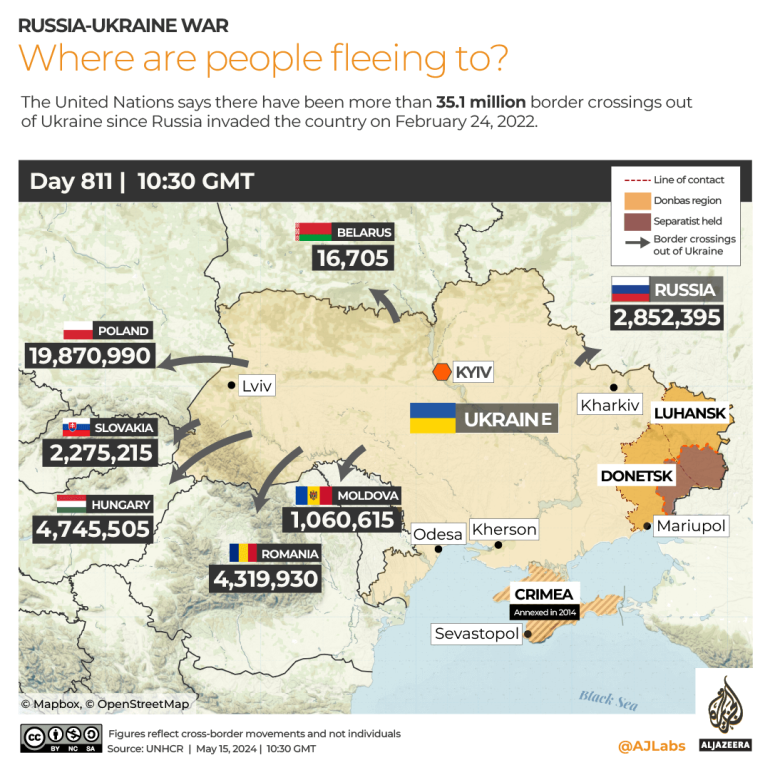Belarusian President Alexander Lukashenko said Russian soldiers had begun to train with the Belarusian military in tactical nuclear weapons, which the Kremlin has hinted could be used on the battlefield in Ukraine.
“An escalation is ongoing. What should we do in this situation? We need to keep powder dry, including these lethal weapons,” Russian official news agency TASS quoted him as saying.
Russian forces opened a new front in Ukraine’s northern Kharkiv region, seizing villages near the border – an offensive Ukrainian officials had warned about days earlier.
Meanwhile in Moscow, President Vladimir Putin named an economist to streamline his Ministry of Defence and nationalise Russian defence industries. Some observers believed that was an indication of Putin’s long-term plans to prepare Russia to fight NATO.
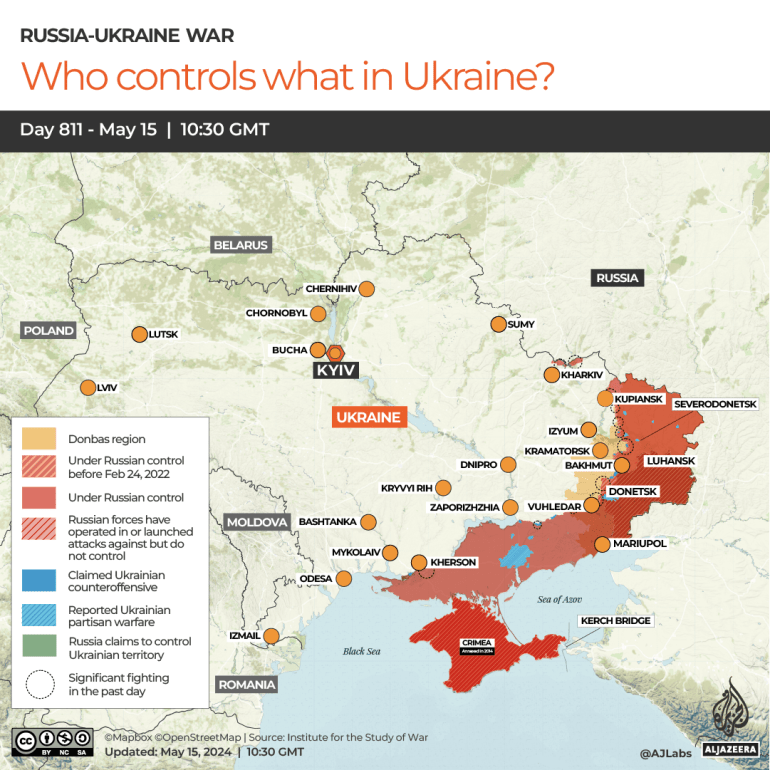
A new ground invasion
Russian forces opened a northern front on Friday, contesting territory they abandoned at the end of May 2022, after failing to capture Kyiv, Chernihiv, Sumy and Kharkiv, Ukraine’s major northern cities.
Ukrainian and Western experts said it aimed to sow panic, divert scant resources before new US weapons arrived, and facilitate territorial gains in Ukraine’s east, where the fiercest fighting was taking place.
Ukrainian President Volodymyr Zelenskyy said in his Sunday evening address: “The intention of the strikes in Kharkiv Oblast is to stretch our forces and undermine the moral and motivational basis of Ukrainians’ ability to defend themselves.”
“[Russian forces were] likely conducting the initial phase of an offensive operation north of Kharkiv City that has limited operational objectives but is meant to achieve the strategic effect of drawing Ukrainian manpower and materiel from other critical sectors of the front in eastern Ukraine,” said the Institute for the Study of War (ISW), a Washington-based think tank.
The numbers of Russian troops appeared to confirm this. Ukrainian military commentators Konstantyn Mashovets and Alexander Kovalenko said Russia had committed about 2,000 soldiers to the front line, with about 2,000 more in immediate reserve and almost 4,000 due to arrive within a week of the initial attack.
These forces struck at two points on the border, one bound for the settlement of Lyptsi, 18km north of Kharkiv city, and the other bound for Vovchansk, about 30km (18.6 miles) to the east.
Russia’s Defence Ministry claimed five villages on Saturday and another four on Sunday, although it was not clear if Ukraine had been fully in control of these border settlements beforehand. By Tuesday, Russian and Ukrainian forces were fighting inside the settlements of Lyptsi and Vovchansk, approximately 5km (3 miles) from the border.
“This week, the situation in Kharkiv Oblast has significantly worsened,” Ukrainian commander-in-chief Oleksandr Syrskii wrote on the Telegram messaging app. “Currently, there are ongoing battles in the border areas … The situation is difficult, but the defence forces of Ukraine are doing everything to hold defensive lines and positions.”
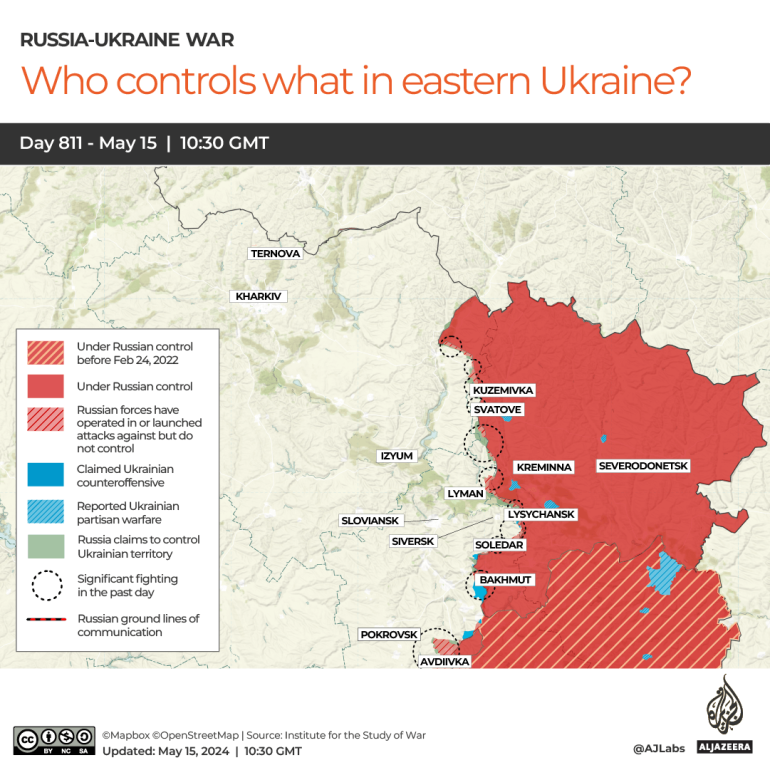
The new front complicated Ukraine’s defence.
The general staff said 146 combat clashes took place across all fronts on Sunday – up from 84 four days earlier.
It was unclear if Russia’s distraction gambit worked. Its forces did inch forward a little on the principal eastern fronts of Chasiv Yar and Avdiivka on Saturday, but on Monday Ukrainian defenders cleared a Russian position out of a forest area in Bohdanivka, north of Chasiv Yar, to frustrate an encircling effort.
Russia has been gradually escalating for weeks, ahead of what Ukraine expects will be a major offensive this summer.
The UK Ministry of Defence estimated Russian attacks had increased by 17 percent between March and April, and that three-quarters of them were taking place in the east – where Russia has said its immediate goal is to complete the conquest of Luhansk and Donetsk.
Nor did the northern front come entirely by surprise.
Ukrainian officials had warned of a buildup of at least 35,000 soldiers north of the border. And Sergey Lavrov, the Russian foreign minister, had announced Moscow’s intention of seizing Kharkiv city on April 19, as part of Putin’s plan to establish a “sanitary zone” 10km (6 miles) deep inside Ukraine, to keep Russian settlements outside the range of Ukrainian artillery.
Ukraine’s air defences are weak and its weapons stockpiles remain low.
Russia appeared to be using all its available resources to attack Ukraine during a window of weakness.
The US sent almost no weapons to Ukraine in the first four months of the year, because Republicans in Congress opposed US President Joe Biden’s $60bn supplemental military spending request for Ukraine.
Biden signed that bill on April 24, and weapons have reportedly begun to flow again, but Ukrainian ground forces commander Oleksandr Pavlyuk told The Economist that Russian forces enjoyed a 20-to-one artillery advantage in the east. Putin seemed to be pushing for territorial gains before US and European weapons brought Ukrainian forces back up to strength.
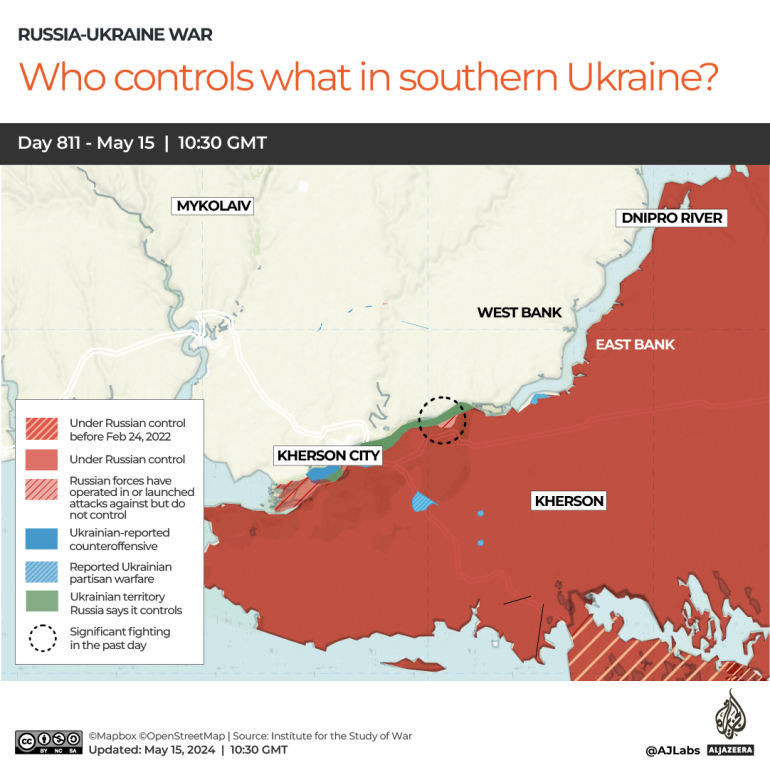
It was a similar story in air defence.
Pavlyuk said Russia enjoyed “overwhelming air superiority,” enabling it to release devastatingly powerful glide bombs on Ukrainian defensive positions.
Zelenskyy said 9,000 of these had been dropped by late April, a rate of 76 a day.
The Wall Street Journal calculated that Ukraine had shot down 46 percent of incoming Russian missiles in the past six months, compared with a 73 percent shootdown rate in the previous six-month period. A New York Times tally came to a similar conclusion: Ukraine was stopping fewer than half of incoming missiles, compared with 80 percent a year ago.
“There’s no doubt, there’s been a cost in the months-long delay in getting the supplementary budget request approved and the equipment sent out to- to Ukraine,” Blinken said on CBS’s news programme Face the Nation.
Ukraine’s deep strikes
Even as it fought the new invasion from the north, Ukraine continued to launch missiles and drones during the past week, which struck Russian energy infrastructure and harassed its lines of supply.
Ukrainian drones hit an oil refinery and oil transshipment depot in Bashkortostan on May 9.
The following day, Ukrainian military intelligence said, it struck the Perviy Zavod refinery in Russia’s Kaluga region, which it had again struck a month earlier.
On Saturday, Ukrainian special services told the Suspilne new outlet that they had struck a Lukoil refinery in the Volgograd region. And on Sunday Ukrainian military intelligence said it had struck the Kaluganefteprodukt oil depot in Kaluga and the Novolipetsk Metallurgical Plant in the Lipetsk region, while again striking the Lukoil refinery in Volgograd.
There was a further strike on Tuesday – this time on a train likely transporting fuel to the front in Samofalovka.
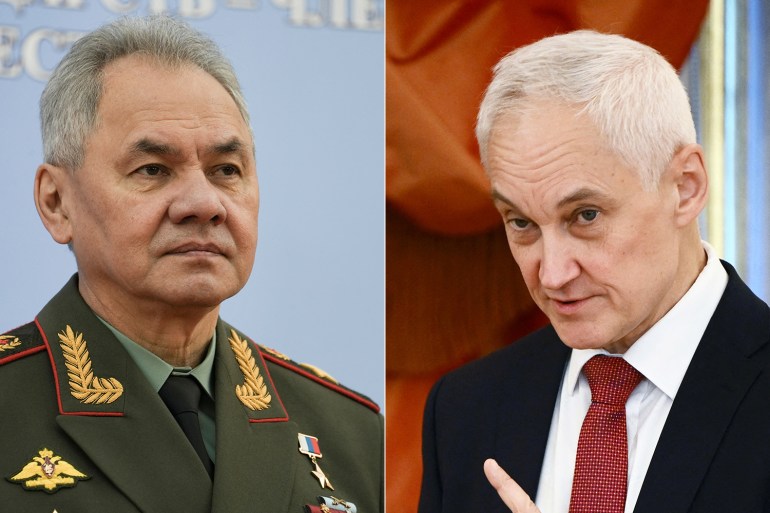
Putin appeared to be digging in for a streamlining of Russian military procurement and a refashioning of Russian defence industries, by appointing an economist as defence minister on Sunday.
Putin named economist Andrei Belousov as defence minister, shifting Sergei Shoigu out of the post he has served for 12 years.
Kremlin spokesman Dmitry Peskov told reporters that the decision was linked to the need of “making the economy of the security bloc part of the country’s economy”.
There was also an economic priority in Prime Minister Mikhail Mishustin’s proposal to name Industry Minister Denis Manturov as first deputy prime minister.
“The status of the deputy prime minister who is in charge of the industry sector should be elevated as it is crucial to provide technological leadership,” Mishustin’s spokesman, Boris Belyakov, said.
“These high-level reshuffles following the Russian presidential election strongly suggest that Putin is taking significant steps towards mobilising the Russian economy and defence industrial base to support a protracted war in Ukraine and possibly prepare for a future confrontation with NATO,” said the ISW.
